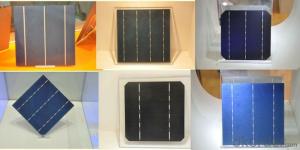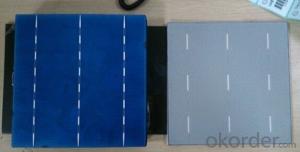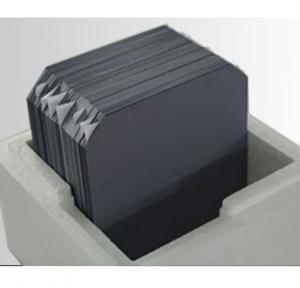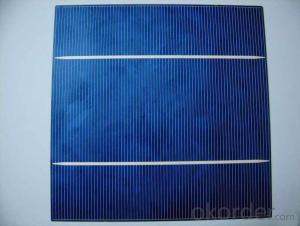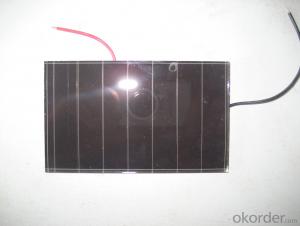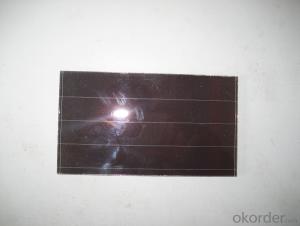Solar Cell High Quality A Grade Cell Polyrystalline 5v 17.2%
- Loading Port:
- Shanghai
- Payment Terms:
- TT OR LC
- Min Order Qty:
- 1000 pc
- Supply Capability:
- 100000 pc/month
OKorder Service Pledge
OKorder Financial Service
You Might Also Like
Specifications
hot sale solar cell
1.16.8%~18.25% high efficiency
2.100% checked quality
3.ISO9001/ISO14001/TUV/CE/UL
4.stable performance
We can offer you the best quality products and services, don't miss !
POLY6'(156*156)
Polycrystalline Silicon Solar cell
Physical Characteristics
Dimension: 156mm×156mm±0.5mm
Diagonal: 220mm±0.5mm
Thickness(Si): 200±20 μm
Front(-) Back(+)
Blue anti-reflecting coating (silicon nitride); Aluminum back surface field;
1.5mm wide bus bars; 2.0mm wide soldering pads;
Distance between bus bars: 51mm . Distance between bus bars :51mm .
Electrical Characteristics
Efficiency(%) | 18.00 | 17.80 | 17.60 | 17.40 | 17.20 | 16.80 | 16.60 | 16.40 | 16.20 | 16.00 | 15.80 | 15.60 |
Pmpp(W) | 4.33 | 4.29 | 4.24 | 4.19 | 4.14 | 4.09 | 4.04 | 3.99 | 3.94 | 3.90 | 3.86 | 3.82 |
Umpp(V) | 0.530 | 0.527 | 0.524 | 0.521 | 0.518 | 0.516 | 0.514 | 0.511 | 0.509 | 0.506 | 0.503 | 0.501 |
Impp(A) | 8.159 | 8.126 | 8.081 | 8.035 | 7.990 | 7.938 | 7.876 | 7.813 | 7.754 | 7.698 | 7.642 | 7.586 |
Uoc(V) | 0.633 | 0.631 | 0.628 | 0.625 | 0.623 | 0.620 | 0.618 | 0.617 | 0.615 | 0.613 | 0.611 | 0.609 |
Isc(A) | 8.709 | 8.677 | 8.629 | 8.578 | 8.531 | 8.478 | 8.419 | 8.356 | 8.289 | 8.220 | 8.151 | 8.083 |
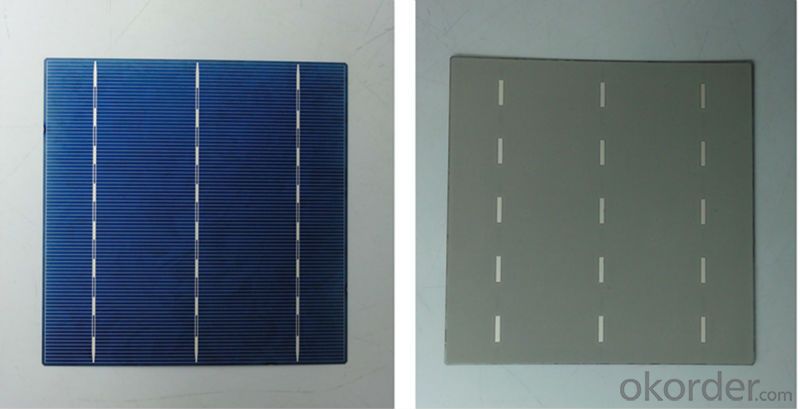
MONO5'(125*125mm)165
Monocrystalline silicon solar cell
Physical Characteristics
Dimension: 125mm×125mm±0.5mm
Diagonal: 165mm±0.5mm
Thickness(Si): 200±20 μm
Front(-) Back(+)
Blue anti-reflecting coating(silicon nitride); Aluminum back surface field;
1.6mmwide bus bars; 2.5mm wide soldering pads;
Distance between bus bars: 61mm . Distance between bus bars :61mm .
Electrical Characteristics
Efficiency(%) | 19.40 | 19.20 | 19.00 | 18.80 | 18.60 | 18.40 | 18.20 | 18.00 | 17.80 | 17.60 | 17.40 | 17.20 |
Pmpp(W) | 2.97 | 2.94 | 2.91 | 2.88 | 2.85 | 2.82 | 2.79 | 2.76 | 2.73 | 2.70 | 2.67 | 2.62 |
Umpp(V) | 0.537 | 0.535 | 0.533 | 0.531 | 0.527 | 0.524 | 0.521 | 0.518 | 0.516 | 0.515 | 0.513 | 0.509 |
Impp(A) | 5.531 | 5.495 | 5.460 | 5.424 | 5.408 | 5.382 | 5.355 | 5.328 | 5.291 | 5.243 | 5.195 | 4.147 |
Uoc(V) | 0.637 | 0.637 | 0.636 | 0.635 | 0.633 | 0.630 | 0.629 | 0.629 | 0.628 | 0.626 | 0.626 | 0.625 |
Isc(A) | 5.888 | 5.876 | 5.862 | 5.848 | 5.839 | 5.826 | 5.809 | 5.791 | 5.779 | 5.756 | 5.293 | 5.144 |

FAQ:
Q:How can i get some sample?
A:Yes , if you want order ,sample is not a problem.
Q:How about your solar panel efficency?
A: Our product efficency around 17.25%~18.25%.
Q:What’s the certificate you have got?
A: we have overall product certificate of ISO9001/ISO14001/CE/TUV/UL
- Q:Development trend of monocrystalline silicon wafer
- In addition, it is conducive to the healthy development of the photovoltaic industry, is conducive to photovoltaic products into millions of households."LDK LDK is a high-tech photovoltaic enterprise focusing on the research and development, production and sales of solar polysilicon material, ingot and polycrystalline silicon wafer. NYSE Listed Companies in 2008 to achieve sales revenue is expected to reach $1 billion 750 million. The photovoltaic business and become the world's first to enter the "GW club". Total orders exceeded 13GW, becoming the world's largest polysilicon suppliers in hand orders.
- Q:It is said that monocrystalline silicon, polycrystalline silicon wafer cutting requirements and problems are still quite a lot of
- 1, the impurity line caused by impurities in polycrystalline silicon ingot, slicing process can not completely remove the lead line on a silicon wafer.2, scratch line caused by mortar in large SIC particles or caking mortar. In the process of cutting, SIC particles stuck in between steel wire and silicon can not overflow, cause.Forms: including the whole line and half line marks, concave line, shiny, more narrow than the other.
- Q:How is a mounting structure attached to a solar silicon wafer?
- A mounting structure is typically attached to a solar silicon wafer using a conductive adhesive or soldering technique. The adhesive or solder is applied to the backside of the wafer, and the mounting structure is then pressed onto it. This ensures a secure and reliable connection between the wafer and the mounting structure, enabling the efficient installation and operation of the solar panel.
- Q:How does the efficiency of a solar silicon wafer change with altitude?
- The efficiency of a solar silicon wafer does not change significantly with altitude. Altitude primarily affects the intensity of sunlight, but it has a minimal impact on the efficiency of a solar silicon wafer. The main factors influencing efficiency are temperature, tilt, and shading, rather than altitude.
- Q:What is the surface hardness of monocrystalline silicon and polycrystalline silicon wafers
- When the contact depth is above 60NM, silicon wafer contact stiffness and contact depth of a linear relationship between the hardness and elastic modulus remained unchanged, the measured value of hardness and elastic modulus of silicon, are about 12.5GPa and 165.6GPa.
- Q:How are solar silicon wafers protected from fire or overheating?
- Solar silicon wafers are protected from fire or overheating through various measures, including the use of fire-resistant encapsulation materials and thermal management systems. These encapsulation materials, such as EVA (ethylene-vinyl acetate) or PVB (polyvinyl butyral), act as a protective layer around the solar cells, preventing direct contact with air and reducing the risk of fire. Additionally, thermal management systems, such as heat sinks or cooling fans, are employed to dissipate excess heat generated during operation, ensuring the wafers remain within a safe temperature range and minimizing the chances of overheating.
- Q:Can solar silicon wafers be used in thin-film solar cell technology?
- No, solar silicon wafers cannot be used in thin-film solar cell technology. Thin-film solar cells are typically made of materials like amorphous silicon, cadmium telluride, or copper indium gallium selenide, which are deposited as thin layers onto a substrate, eliminating the need for silicon wafers.
- Q:How are solar silicon wafers affected by potential-induced degradation?
- Solar silicon wafers are adversely affected by potential-induced degradation (PID). PID occurs when high voltage potential is applied to the module, leading to a decrease in performance and efficiency. This degradation is primarily caused by the migration of ions, such as sodium, from the glass surface to the silicon wafer, resulting in increased leakage currents and reduced power output. To mitigate PID, various measures like using anti-PID modules or implementing appropriate system grounding techniques are employed in solar panel installations.
- Q:How long do solar silicon wafers last in a solar panel?
- Solar silicon wafers can last for several decades in a solar panel, typically around 25 to 30 years.
- Q:Are solar silicon wafers affected by voltage fluctuations?
- Yes, solar silicon wafers can be affected by voltage fluctuations. Fluctuations in voltage can impact the performance and efficiency of solar panels, as they rely on a stable and consistent voltage to generate electricity. Variations in voltage can cause fluctuations in current, which can lead to reduced power output or even damage to the solar cells. Therefore, it is important to ensure a stable and well-regulated voltage supply for optimal performance of solar silicon wafers.
1. Manufacturer Overview |
|
|---|---|
| Location | |
| Year Established | |
| Annual Output Value | |
| Main Markets | |
| Company Certifications | |
2. Manufacturer Certificates |
|
|---|---|
| a) Certification Name | |
| Range | |
| Reference | |
| Validity Period | |
3. Manufacturer Capability |
|
|---|---|
| a)Trade Capacity | |
| Nearest Port | |
| Export Percentage | |
| No.of Employees in Trade Department | |
| Language Spoken: | |
| b)Factory Information | |
| Factory Size: | |
| No. of Production Lines | |
| Contract Manufacturing | |
| Product Price Range | |
Send your message to us
Solar Cell High Quality A Grade Cell Polyrystalline 5v 17.2%
- Loading Port:
- Shanghai
- Payment Terms:
- TT OR LC
- Min Order Qty:
- 1000 pc
- Supply Capability:
- 100000 pc/month
OKorder Service Pledge
OKorder Financial Service
Similar products
New products
Hot products
Related keywords
